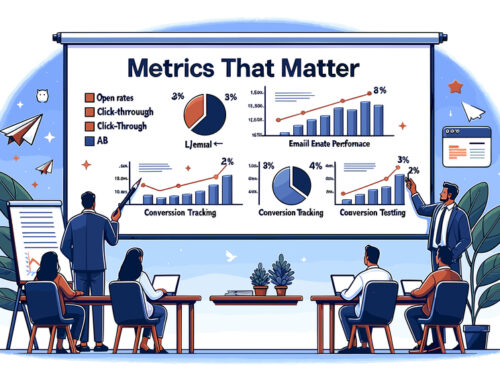
If you want to know how to get better at marketing and managing multiple locations effectively, this guide is for you.
We cover essential strategies such as maintaining consistent branding, tailoring local marketing, streamlining operations, and enhancing communication.
These tips will help you improve efficiency and customer experience across all your locations.
Establish a Unified Marketing Strategy
For businesses operating in multiple locations, it is critical to attract leads and nurture them into devoted customers without losing the integrity of a consistent brand voice.
By crafting an integrated marketing strategy that encompasses the essence of the company’s identity while accommodating distinct regional customer bases, organizations can achieve uniformity in their message and relevance within various markets.
Developing a strategic marketing agenda is essential for harmonizing your business’ fundamental character with local market nuances. This ensures that all promotional activities are coherent, offering customers a unified experience regardless of which location they interact with.
Realizing this requires maintaining steady branding across all fronts, tailoring marketing endeavors to specific locales, and leveraging advanced digital tools for efficient outreach and engagement.
Consistent Branding Across Multiple Locations
Maintaining a coherent brand identity through identical logos, colors, and messaging across multiple locations contributes to a consistent customer experience. Such uniformity in branding elements helps solidify customer recognition as they associate these features with your company’s core values and dependable communication style.
Standardized processes are crucial for establishing a homogenous customer experience at all branches. This practice aids in efficiently managing multiple locations by ensuring that each location delivers an experience that strengthens the customer’s connection to your brand regardless of which branch they visit.
An effective centralized system for lead management is essential when overseeing lead generation efforts across various locations.
Localized Marketing Efforts
Fine-tuning marketing tactics to the unique traits of different locations can markedly improve customer engagement. When promotional materials reflect the cultural and linguistic norms of local consumers, they not only preserve brand authenticity but also heighten customer interaction.
Understanding the culture and preferences within a locality is crucial for devising marketing efforts that effectively appeal to intended audiences. Ensuring precise and uniform listings on Google Business Profile helps draw in customers from surrounding areas while establishing a robust online presence.
Each listing must display localized contact information, encompassing the particular phone number and address pertinent to that venue. Emphasizing exclusive services and distinctive features of individual locations boosts their visibility, thus attracting regional patrons.
Utilize Digital Marketing Tools
Utilizing scheduling software can significantly improve the process of organizing routine team gatherings. By employing tools with functionalities such as shared calendars and meeting booking, valuable time is conserved in coordinating these meetings.
Tailoring email marketing initiatives with messages personalized to specific locations can increase engagement among local audiences. For businesses that operate across multiple locations, obtaining backlinks from reputable local sources serves to amplify their visibility in local searches and bolster their search engine rankings.
Employing geo-targeting techniques within PPC advertising campaigns allows for the crafting of bespoke ads that are more relevant to specific regional markets, thereby enhancing user interaction. Developing a potent digital strategy is essential for effectively reaching varied demographics throughout different locations.
Streamline Business Processes

Implementing uniform processes across multiple locations can ease management tasks and enhance operational performance. Replicating the successful practices of an established store creates a blueprint for managing various locations. An essential operations plan delivers uniformity in every subsequent location.
Cloud-based applications are crucial to efficient functionality within businesses operating on multiple sites. Such tools are vital in coordinating numerous teams and unifying business protocols throughout venues.
To refine business activities, adopting standard operating procedures (SOPs), managing resources from a central point, and ensuring consistent training across all locations is essential. This approach assists with resource management and effectively overseeing multiple teams.
Implement Standard Operating Procedures (SOPs)
Standard Operating Procedures (SOPs) facilitate uniformity and maintain quality consistency across various locations, enhancing operational efficiency. Standardized tools and technologies simplify central reporting, making it easier to manage workflows effectively.
Leveraging digital marketing instruments can significantly boost campaign productivity through automation while providing critical insights into campaign performance via analytics.
Employing marketing automation platforms enables seamless management of promotional initiatives at different venues and monitoring of their success rates. Such an approach not only bolsters operational proficiency but also ensures that all marketing endeavors are in sync with the business’s broader strategic aims.
Centralized Resource Management
Centralized platforms enhance the ease of access and optimize processes throughout various sites. These systems support uniformity in data across multiple locations, facilitating better control over resource and inventory tracking while minimizing inaccuracies.
This strategy simplifies resource management, guaranteeing that every location has the requisite tools and knowledge. It also bolsters communication management and fosters improved collaboration among different teams.
Regular Training and Development
Structured training and a centralized library of resources contribute to operational uniformity. Employees can receive instruction by participating in person, which facilitates interaction, or through online webinars.
Central resource management enables teams to easily access essential materials, thereby improving the efficiency of their training.
Ongoing education and development are pivotal in ensuring employees have the requisite skills and promoting an environment dedicated to continuous advancement. This is vital for upholding superior service levels throughout various locations.
Enhance Communication Channels

Encouraging transparent dialogue and teamwork fosters unity among staff members at multiple locations.
Establishing a strong company culture helps distant workers feel appreciated and linked to the enterprise’s goals. Continuously conveying the fundamental principles and vision of the corporation aligns employees’ endeavors, enhancing their bond with the organization’s objectives.
Effectively managing multiple locations necessitates instituting exemplary communication strategies. By standardizing procedures, obstacles can be transformed into opportunities for development across all your locations and other locales.
Leveraging cooperative tools, organizing consistent gatherings, and advocating for efficient communication protocols can improve how we manage conversations amongst various sites.
Use Collaborative Tools
Investing in digital tools such as project management and communication applications improves team coordination across various locations.
Cloud-based systems enhance accessibility and the control of resources regardless of location. Tools like Slack and Wrike are instrumental in promoting efficient project management and fostering team interaction, thus improving collaboration within a digital workspace.
Implementing an intranet system optimizes internal communication by guaranteeing that critical updates reach all employees uniformly. By efficiently disseminating essential information, an intranet promotes greater employee engagement throughout the organization.
Schedule Regular Meetings
Holding regular meetings, whether in person or through virtual platforms, is essential for keeping team members aligned and promptly resolving any arising concerns within teams.
Establishing a routine of weekly or bi-weekly gatherings fosters the timely realignment of objectives and quick address of issues.
Such consistent meetings provide an avenue for performance conversations between managers, which boosts operational efficiency. Maintaining this regimen guarantees that all team members work cohesively and have a shared understanding to accomplish collective aims effectively.
Promote Good Communication Practices
Ensuring each team member understands their role leads to responsible practices and efficient workflows in different locations. When employees are given the authority to make decisions within their domain of expertise, it fosters effective delegation and leverages individual strengths for better team functioning.
Fostering an environment where open dialogue and consistent feedback are prioritized is essential to enhancing employee management across multiple teams. This practice nurtures trust among team members and is fundamental when managing multiple groups simultaneously.
Effective communication channels help align all team members with the company’s objectives, which is crucial in coordinating efforts between various teams.
Strengthen Company Culture
It’s crucial for employees situated across various locations to have a deep understanding of your company’s culture, vision, values, and mission. To foster employee engagement effectively, precise communication regarding the company’s guiding principles and objectives must occur. Providing uniform training via online platforms guarantees that all team members in diverse locations assimilate consistent information.
Team-building exercises and social events can strengthen the bond between employees and the organization. Implementing effective communication paired with regular team-building activities contributes significantly to an employee’s sense of belonging within the company.
Hosting such activities aimed at team bonding, celebrating key achievements together, and regularly sharing insights on vision and values are potent strategies for reinforcing your company’s ethos amongst your teams.
Organize Team Building Activities

Arrange for team-building activities and local meetups to cultivate a sense of unity and connection among staff members. These gatherings allow employees to engage in different settings, strengthening bonds and promoting better teamwork.
Establishing robust teams throughout various locations involves choosing dependable personnel for leadership positions. It is advantageous to elevate individuals within the company who have shown promise in these roles.
Celebrate Milestones and Achievements
Recognizing personal and collective achievements is key to encouraging a constructive workplace atmosphere. Celebrating milestones spurs motivation and enhances the feeling of success among employees, leading to heightened morale and increased productivity.
By celebrating individual and group accomplishments, a sense of fulfillment is cultivated and propels team members’ continued involvement. This approach incentivizes employees, cementing their bond with the company and improving overall effectiveness.
Communicate Vision and Values
Having well-defined SOPs in place means that every employee is aware of and follows identical procedures, enhancing customer service and ensuring operations uniformity.
Keeping employees regularly informed about the company’s vision and values maintains their engagement and ensures they work towards common corporate objectives.
Employees who grasp and adopt the company’s vision and values exhibit greater motivation and commitment to their roles. Ensuring that employee behaviors are consistent with the company’s overarching goals nurtures a robust organizational culture while improving overall performance.
Optimize Leadership and Management

A definitive leadership framework is key to effectively managing multiple business locations.
Establishing an efficient communication system empowers managers to make informed decisions and perform regular check-ins as needed. Solid leadership, along with essential tools and training, guarantees that each location functions effectively and adheres to the company’s objectives.
Pinpointing potential leaders, providing them with appropriate training, distributing responsibilities aptly, and assessing performance through feedback mechanisms can enhance both leadership quality and management practices across various locations.
Identify and Train Leaders
Spotting potential leaders within the current workforce or among fresh hires is essential, focusing on their expertise and aptitude for team leadership.
Conducting customized training workshops to bolster leadership competencies and nurture the career advancement of prospective leaders is imperative. Such a strategy guarantees that these leaders are prepared to rise to the occasion when overseeing multiple teams across various locations.
Allocating resources to cultivate leadership skills creates a robust reservoir of future executives poised to propel expansion and triumph in different locales.
Delegate Responsibilities
At each location, pinpoint prospective leaders who can contribute to robust management and offer them professional development opportunities. By holding continuous training sessions for the management teams, they will maintain alignment with company objectives and augment their managerial capabilities.
Consistently evaluate managers’ performance at each site and provide beneficial critiques that promote better operational efficiency and responsibility. This strategy empowers team members regarding their duties, which in turn fosters active participation in achieving the company’s success.
Monitor Performance and Provide Feedback
Constructive feedback encourages continuous enhancement in teams that oversee various locations. Monitoring team effectiveness helps pinpoint areas for improvement and increases general productivity.
Conducting routine performance evaluations allows for the creation of plans that support the team’s development and flexibility.
Instituting a feedback cycle improves communication within teams and elevates organizational functioning throughout different locations. This method ensures that all employees are in tune with the company’s aims, promoting persistent high-quality performance.
Legal and Compliance Considerations
Investigate and comprehend the legal mandates pertinent to each location where operations are conducted.
Safeguarding your business name, trademarks, and other intellectual properties at various locations is crucial. Seeking advice from legal experts who can help navigate intricate regulatory landscapes is vital in guaranteeing complete adherence and averting potential legal complications.
We must recognize the significance of grasping local laws, preserving intellectual property rights, and enlisting the assistance of legal professionals to ensure that all requirements for legality and compliance are sufficiently addressed.
Understand Local Regulations
Businesses must be aware of and adhere to legal requirements when branching out into new states. Varying regulations and statutory mandates can influence the operations of businesses in disparate locations.
When venturing into a new market, one possible legal hurdle is encountering an already established use of an identical business name or emblem, which may cause disputes.
By conforming to the local laws at each location, businesses can avoid legal complications and ensure seamless functioning within novel territories.
Protect Intellectual Property
Companies must ensure that their business name and branding are unique to the new location they are expanding into, thereby circumventing any trademark conflicts.
It is vital for a business to safeguard its trademarks and other intellectual property when it expands to multiple locations to avoid legal entanglements.
By taking preventive measures to secure intellectual property rights, businesses can maintain their brand’s distinctiveness and recognition, thus shielding themselves from potential legal challenges.
Engage Legal Experts
When businesses expand, it’s crucial for them to investigate intellectual property concerns and adhere to local laws and regulations. Seeking advice from legal experts is vital in maneuvering through the multifaceted regulatory landscapes that come with business growth.
These professionals offer indispensable counsel that can assist businesses in sidestepping legal traps and skillfully managing the complexities of various regulatory systems.
Involving legal authorities helps safeguard their operations, ensuring complete compliance across all locations where their business activities occur.
Summary
To manage multiple locations effectively, it is imperative to integrate strategic marketing tactics with efficient business processes, reinforce communication channels, and cultivate a strong company culture.
Establishing consistent marketing approaches across all locations, refining operational procedures for efficiency, bolstering methods of communication within the company, fortifying the organizational culture while focusing on leadership optimization and adhering to legal standards are essential practices businesses must employ to adeptly navigate the intricacies associated with managing several branches.
It’s important to recognize that perfecting the art of overseeing various outlets is continuous. Businesses must regularly evaluate their approach and make necessary enhancements to maintain an edge in performance and foster ongoing expansion and success.
Welcoming both challenges and opportunities brought about by growth allows you, as a leader, to not only guide your team toward achieving new accomplishments but also ensure your business thrives at every location.





